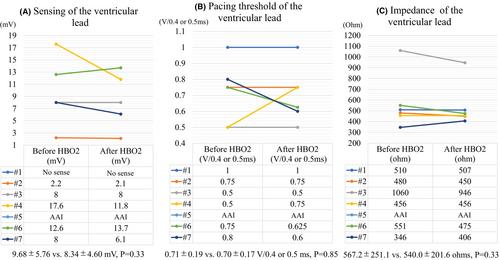The impact of hyperbaric oxygen treatment for cardiovascular implantable electronic devices
Abstract
Introduction
The safety of hyperbaric oxygen treatment (HBO2) in patients with cardiovascular implanted electronic devices (CIED) remains unclear.
Methods
We conducted a retrospective analysis of seven CIED patients (median age 79 [73–83] years, five males [71.4%]), including five with pacemakers and two with implantable cardioverter defibrillators (ICD), who underwent HBO2 between June 2013 and April 2023. During the initial session, electrocardiogram monitoring was conducted, and CIED checks were performed before and after the treatment. In addition, the medical records were scrutinized to identify any abnormal CIED operations.
Results
All seven CIED patients underwent HBO2 within the safety pressure range specified by the CIED manufacturers or general pressure test by the International Organization for Standardization (2.5 [2.5–2.5] atmosphere absolute × 18 [5–20] sessions). When comparing the CIED parameters before and after HBO2, no significant changes were observed in the waveform amplitudes, pacing thresholds, lead impedance of the atrial and ventricular leads, or battery levels. All seven patients, including two with the rate response function activated, exhibited no significant changes in the pacing rate or pacing failure. Two ICD patients did not deactivate the therapy, including the defibrillation; however, they did not experience any arrhythmia or inappropriate ICD therapy during the HBO2.
Conclusion
CIED patients who underwent HBO2 within the safety pressure range exhibited no significant changes in the parameters immediately after the HBO2 and had no observable abnormal CIED operations during the treatment. The safety of defibrillation by an ICD during HBO2 should be clarified.


 求助内容:
求助内容: 应助结果提醒方式:
应助结果提醒方式:


